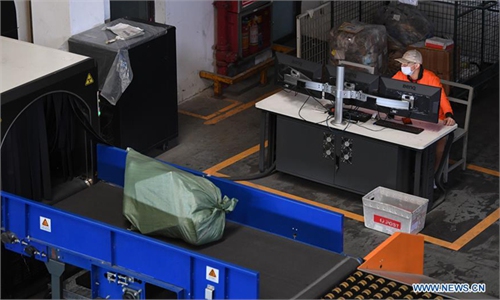Cargo flight routes will expand
Temporary slowdown caused by coronavirus pandemic in the world

A China Postal Airlines flight CF9051 lands at Xining Caojiabao International Airport, marking the cargo air route with the largest carrying capacity across the Qinghai-Tibetan Plateau comes online. Photo: cnsphoto
In less than one week, a number of Chinese cities have witnessed the launch of international cargo routes.
Henan-based China Central Longhao Airlines started its cargo flight from Zhengzhou, Central China's Henan Province to Manila on Wednesday. On June 10, Qingdao, East China's Shandong Province launched a direct all-cargo flight route to Almaty, Kazakhstan. This is the second cargo route flying from Qingdao airport to a Shanghai Cooperation Organization country after a new route to Moscow.
Shenzhen Baoan International Airport also ushered in a new round of opening up of international cargo routes, and the frequency of international cargo flights from Shenzhen to Cologne, Manila, Bangkok, and Paris have been further enhanced. At present, Shenzhen airport has extended cargo services to 28 overseas cities, and there are nearly 300 overseas cargo flights every week.
The fast growing of cargo business in recent years is in line with a rapid recovery of China's economy and strong trade supports, as Chinese foreign trade is still in upward amid a slowdown global economy and the impact of pandemic.
Official data revealed that foreign trade in the first quarter of 2021 surged 29 percent compared with the same period last year, and the growth rate of import, export both hit the highest level in the past 10 years, and China has outstanding performance among the major economies in the world.
Market observers said the e-commerce and express delivery industry are also another driving force for the growth of air cargo in both China and around the world.
Cross-border e-commerce is on course to grow to make up 20 percent of global air cargo shipments by 2022 - a doubling of its share since 2017 - despite a slowing growth rate during the COVID-19 pandemic as a result of price hikes caused by capacity constraints, according to an article posted on lloydsloadinglist.com.
The article said the slowdown in cross border e-commerce growth (by air) is likely to be a temporary 'blip'. When the industry returns to a more balanced supply situation in air cargo - and in ocean cargo, for that matter - it is expected to see volumes gathering momentum again and for cross-border to keep on outperforming growth rates for domestic e-commerce. And, 70-80 percent of cross border e-commerce traffic will continue to be transported by air.
The International Air Transport Association released April data for global air cargo markets showing that air cargo demand continued to outperform pre-COVID levels with demand up 12 percent.
Gap with overseas players
Chinese civil aviation regulator has vowed to enhance cargo transport capacity, given the fact that there is a big gap compared with developed countries.
Feng Zhenglin, director of the Civil Aviation Administration of China (CAAC) said on June 9 that China has 11 aviation cargo companies which are small in scale, and their business normally covers neighboring countries and major markets in Europe and America, and "their competitiveness is not strong."
Official data showed that in 2019, the market share of China's freight companies on international routes was only 34 percent.
Chinese airlines that lack an all-cargo aircraft could encounter more barriers ahead. Feng said China has a total of 190 all-cargo aircrafts, which is only about one fourth of that of FedEx. Among them, there are only 43 large freighters, and FedEx and United Parcel has 95 and 65 large freighters.
"Enhancing air cargo capacity is an issue that civil aviation industry needs to be solved urgently," Feng said.
CAAC said it vowed to build a network that supports 3-day delivery to major cities around the world.
To promote local cargo transport, different local governments take different subsidies to the cargo flights.
According to a file posted on the official website of Xiamen government in May, the government gives subsidies as high as 720,000 yuan ($111,930) for opening one fixed cargo inter-continental flight, and the maximum subsidy for a single route in each operating year could reach 84 million yuan.
However, market watchers are taking a cautious attitude on the cargo industry after the pandemic, and worried that all-cargo aircraft business could drop, and after the coronavirus was contained, passenger aircraft fleet will continue to expand.


